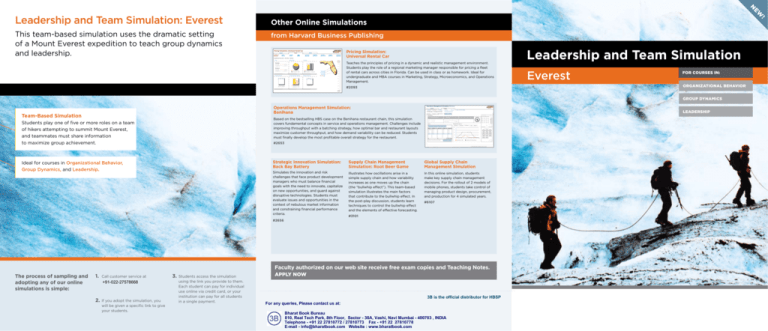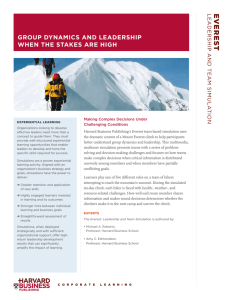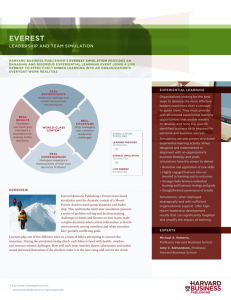
N
!
This team-based simulation uses the dramatic setting
of a Mount Everest expedition to teach group dynamics
and leadership.
EW
Leadership and Team Simulation: Everest
Other Online Simulations
Other Online Simulations
from
Business
Publishing
fromHarvard
Harvard
Business
Publishing
Pricing Simulation: Universal Rental Car
analyze
prepare
dashboard
overview
price
history
market
share
decide
unit
sales
capacity
utilization
universal
fleet size
monthly
net income
market
research
breakeven
calculator
Dashboard Overview - All Cities - October
Unit Sales
Market Share
Prices
OCT
FLORIDA
Weekday
Universal
$44.33
Competitor
$37.15
NOV
H
DEC
H
Weekend
Universal
$36.43
Competitor
$31.57
FULL REPORT >
Universal Fleet Size
JAN
Universal: 44%
Competitor: 56%
Universal: 829,157
Competitor: 1,052,600
FULL REPORT >
FULL REPORT >
Universal Capacity Utilization
Monthly Net Income
Tampa
Orlando
Miami
All Cities
H
FEB
MAR
APR
MAY
JUN
JUL
38,344 vehicles
FULL REPORT >
log out
credits
Pricing Simulation:
Universal Rental Car
Weekday: 94%
Weekend: 71%
FULL REPORT >
high scores
$1,941,519
AUG
FULL REPORT >
SEP
Teaches the principles of pricing in a dynamic and realistic management environment.
Students play the role of a regional marketing manager responsible for pricing a fleet
of rental cars across cities in Florida. Can be used in class or as homework. Ideal for
undergraduate and MBA courses in Marketing, Strategy, Microeconomics, and Operations
Management.
Leadership and Team Simulation
Everest
for coursEs iN:
orgANizAtioNAl bEhAvior
#2093
Developed in partnership with the Monitor Group and Forio Business Simulations.
group dyNAmics
Operations Management Simulation:
Benihana
Team-Based Simulation
Operations Management Simulation Benihana
analyze
prepare
challenge 2
challenge 1
challenge 3
challenge 4
challenge 5
Challenge 2: Design the Bar
view detailed description
Scenario 2
New Scenario
Summary
Scenario 3
lEAdErship
design your best strategy
Decisions
Based on the bestselling HBS case on the Benihana restaurant chain, this simulation
covers fundamental concepts in service and operations management. Challenges include
improving throughput with a batching strategy, how optimal bar and restaurant layouts
maximize customer throughput, and how demand variability can be reduced. Students
must finally develop the most profitable overall strategy for the restaurant.
Students play one of five or more roles on a team
of hikers attempting to summit Mount Everest,
and teammates must share information
to maximize group achievement.
ENTRANCE
Batching Customers
Bar Seats
87
7
Use Batching
55 bar seats
No Batching
14 tables
Results for Run 1
Runs
Summary
Generate 20 Runs
Run with Animation
Financial
Customers
Lost
Served
BAR
200
Run
Profit
Lost Cust.
Drinks
Dinners
Average
$354
42
155
283
Min
$354
42
155
283
Max
$354
42
155
283
Run 1
$354
42
155
283
RESTAURANT
150
100
50
0
6:00
click any row to view the run detail.
Copy to Clipboard
6:30
7:00
7:30
Customers In Bar
8:00
8:30
9:00
9:30 10:00 10:30
Customers In Dining Room
#2653
© 2008 Harvard Business Publishing. All rights reserved.
log out
Ideal for courses in Organizational Behavior,
Group Dynamics, and Leadership.
version 8 (pre-release)
Developed in partnership with Forio Business Simulations. For help contact Harvard Business Publishing Customer Support.
Strategic Innovation Simulation:
Back Bay Battery
Supply Chain Management
Simulation: Root Beer Game
Global Supply Chain
Management Simulation
Simulates the innovation and risk
challenges that face product development
managers who must balance financial
goals with the need to innovate, capitalize
on new opportunities, and guard against
disruptive technologies. Students must
evaluate issues and opportunities in the
context of nebulous market information
and constraining financial performance
criteria.
Illustrates how oscillations arise in a
simple supply chain and how variability
increases as one moves up the chain
(the “bullwhip effect”). This team-based
simulation illustrates the main factors
that contribute to the bullwhip effect. In
the post-play discussion, students learn
techniques to control the bullwhip effect
and the elements of effective forecasting.
In this online simulation, students
make key supply chain management
decisions. For the rollout of 2 models of
mobile phones, students take control of
managing product design, procurement,
and production for 4 simulated years.
#6107
#3101
#2656
Faculty authorized on our web site receive free exam copies and Teaching Notes.
The process of sampling and
adopting any of our online
simulations is simple:
1.
Call customer service at
+91-022-27578668
2.
If you adopt the simulation, you
will be given a specific link to give
your students.
3.
Students access the simulation
using the link you provide to them.
Each student can pay for individual
use online via credit card, or your
institution can pay for all students
in a single payment.
Apply NoW
3B is the official distributor for HBSP
For any queries, Please contact us at:
Bharat Book Bureau
810, Real Tech Park, 8th Floor, Sector - 30A, Vashi, Navi Mumbai - 400703 , INDIA
Telephone - +91 22 27810772 / 27810773 Fax - +91 22 27810778
E-mail - info@bharatbook.com Website : www.bharatbook.com
The simulation dashboard provides
an overview of real-time information
and navigation options.
Leadership and Team Simulation: Everest
prepare
analyze
Each team member must input decisions
on critical resource allocation and ascent
decisions. Failure to communicate
effectively and analyze information
properly as a team has negative
consequences for team performance.
decide
chat
Set decisions for Round 1
Camp
Oxygen Canisters
Medical Supplies
The Sherpas will provide canisters to
you on day 4.
Attempt to reach next camp?
I will return to Camp 2
Leadership and Team Simulation: Everest
Approximate seat time: 60-90 minutes
Product #2650
Provide
aspirin
To
select a climber
I will stay at Camp 3
I will go to Camp 4
Simple but powerful administration tools allow
professors to deconstruct leader behavior and
team dynamics in preparation for class discussion.
Submit Decisions
log out
© 2007 Harvard Business School Publishing Corporation. All rights reserved.
Developed in partnership with Forio Business Simulations. For help contact Harvard Business School Publishing Customer Support.
studENt dAshboArd
AdmiNistrAtioN scrEEN
Leadership and Team Simulation: Everest
prepare
dashboard
overview
weather
conditions
health
status
Teammates can communicate via the
chat tool, simulating a walkie-talkie.
decide
analyze
supplies
remaining
goals
on track
hiking
chat
round
information
Analyze speed
SUMMIT
50°
-50°
1
4
CAMP
Normal
-15° F
Leader
Photographer
CAMP
2
CAMP
Water: 9
Hiking Speed
Physician
Marathoner
Western
Cym
Goals Achieved
1
CAMP
Information
Environmentalist
Khumbu
Khumbu
Icefall
Icefall
Students are assigned a role
as one of five or more team
members on an expedition
to climb Mount Everest. The
goals associated with these
roles are often in conflict and
require compromise for team
achievement.
266.7 feet per hour
log out
Information
Each team includes 5 or more roles, each
with its own unique goals in addition
to team goals. The roles are Leader,
Physician, Photographer, Marathoner,
Environmentalist, and Observer (optional).
4
2
3
Goals
Food: 9
Cognitive vs. Affective Conflict
5
0
O°
Students drill into dashboard
information regarding health,
weather, supplies, and hiking
speed to collectively decide
whether to proceed to the next
camp and how to allocate
limited supplies.
chat
compare
constructs
Cognitive Conflict vs. Affective Conflict
Health
Supplies
scenario setup
team results
class
constructs
Compare Constructs:
Dashboard Overview
Weather
class summary
simulation
summary
Affective Conflict
Students prepare once
(with how-to video, summary,
and role-specific information);
then each round of play requires
players to analyze information
and decide on a course of action.
Leadership and Team Simulation: Everest
Faculty can see student
survey responses,
individual achievement,
and team goal
achievement and can
then discuss during
the post-play debrief.
Class discussion is
essential to provide key
learning points. See the
Facilitator’s Guide for
specific topics to cover.
4
A detailed Teaching Note covers learning
objectives, including:
5
n How leaders shape team decision
making and performance in situations
with time and competitive pressures
6
n How opposing interests and asymmetric
information affect team dynamics
© 2008 Harvard Business School Publishing Corporation. All rights reserved.
Developed in partnership with Forio Business Simulations. For help contact Harvard Business School Publishing Customer Support.
3
2
1
3
BASE
CAMP
The simulation tracks:
— Team performance
— Individual performance
— Group process
n How cognitive biases impair
decision making
n How teams and leaders deal with tradeoffs between short-term task completion
and longer-term task effectiveness
n How teams can solve problems and
improve the way they make decisions
0
2
1
3
4
5
Cognitive Conflict
Cognitive Conflict
Affective Conflict
1
3.8
1.6
view team detail
view survey detail
2
2.4
1.2
view team detail
view survey detail
log out
© 2008 Harvard Business School Publishing Corporation. All rights reserved.
Developed in partnership with Forio Business Simulations. For help contact Harvard Business School Publishing Customer Support.
During play, students complete 2 surveys regarding
team and leader effectiveness. Survey responses are
mapped to important constructs in organizational
behavior.
Administrative access allows professors to:
n Show students an engaging 9-minute introductory
online video.
n Show a short online video in which a mountaineer
who successfully summited Everest discusses
leadership lessons learned on the mountain.
Developed in partnership with Forio Business Simulations
n Allow teams across a single course to play the
simulation at different times.
Authored by:
Michael A. Roberto, Professor, Bryant University
Amy C. Edmondson, Professor, Harvard Business School
n Review a short video covering administrative tools.
The video can serve as an introduction or a refresher
for review just before teaching the simulation.










